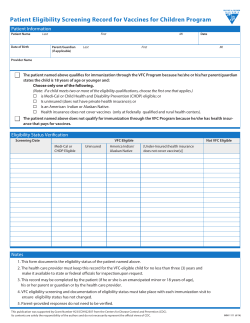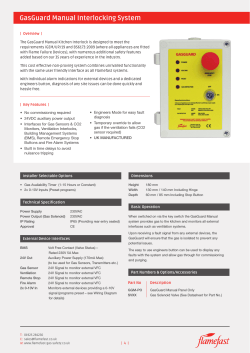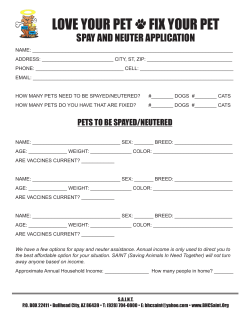
2017 VFC Program Changes - Illinois Chapter, American Academy
IMPORTANT MESSAGE FROM THE VFC PROGRAM TO: VFC Providers FROM: Linda Kasebier, MPH, MSHS VFC Administrator CC: Regional VFC Staff VFC Contractors DATE: April 22, 2015 SUBJECT: Changes Scheduled to Occur in 2017 This memo is to inform all Vaccines for Children (VFC) providers of program changes that will become effective January 1, 2017. As of January 1, 2017, the following recommendations will be requirements for all VFC providers. 1. All VFC providers must have certified calibrated digital data loggers for continuous temperature monitoring for each VFC storage unit and back-up thermometer. 2. Household combination refrigerator/freezers will no longer be allowable for the storage of VFC vaccines. Please see the attached tip sheets for guidance on data loggers and VFC storage units. Purchasing new vaccine storage equipment and thermometers may require planning to accomplish before January 1, 2017. If VFC providers need to replace equipment or thermometers now, we strongly recommend considering the 2017 requirements in purchasing decisions. The CDC Storage and Handling Toolkit at http://www.cdc.gov/vaccines/recs/storage/toolkit/storage-handlingtoolkit.pdf has additional information on digital data loggers and storage equipment. The American Academy of Pediatrics has several storage and handling resource sheets that may provide additional guidance on digital data loggers and storage equipment. The resource sheets are available at http://www2.aap.org/immunization/pediatricians/storageandhandling.html If you have any questions, please contact the IDPH Immunization Promotional Center (IPC) by clicking on the "Contact Us" button in I-CARE and select the "VFC Illinois" category, by e-mail to DPH.Vaccines@illinois.gov or by telephone at 217-786-7500. Please review and post all VFC notices so that all staff involved in vaccine administration, management, patient screening, and billing are aware and receive updated protocols as necessary to comply with VFC program requirements. VFC TIP SHEET: DIGITAL DATA LOGGERS As of January 1, 2017, all VFC providers will be required to use digital thermometers with a glycol-encased (or similar temperature buffer) probe that is able to provide and store data. Such a device is referred to as a data logger. Digital data loggers must have the following features. A detachable probe in a buffered material; Provides current, minimum and maximum temperatures that are easily readable from the outside of the unit; Alarm that actively notifies the provider of out-of-range temperatures; Viewable Low battery indicator; Capability of +/- 1°F (0.5°C) accuracy; Provides memory storage of at least 4,000 readings; Provides capability to not write over old data – stops recording when memory is full; and Equipped with user programmable logging interval (or reading rate). Back-up thermometers must have the same features and set-up (i.e. probe in buffer such as glycol). The backup device should have a different calibration testing schedule so that the back-up is available when the primary is set for testing. Even though the data logger is recording, the temperature will still need to be checked and recorded by office staff twice daily, along with the maximum and minimum temperatures. This can prevent inadvertent loss of vaccine and the potential need for revaccination by assuring that any temperature excursions are identified quickly so that immediate corrective action can be taken. This also provides an opportunity to visually inspect the storage unit, reorganize vaccines by date, and remove any expired vaccines. Data loggers will assist with temperature excursions by being able to identify how long an excursion lasted in between the manual temperature checks by office staff. Unlike a simple min/max thermometer that only provides information about the warmest and coldest temperatures reached, the continuous monitoring data logger provides detailed information on all temperatures recorded at preset intervals. Documentation of known excursions or thermometer malfunctions should be recorded along with the raw data, submitted with the vaccine incident report, and should include corrective actions taken to address the excursions. Data logger temperature data should be downloaded and reviewed weekly, then stored for at least 3 years. Questions to ask vendors about desired specifications: Does this data logger display the current, minimum, and maximum temperature? Is the display outside of the vaccine storage unit (refrigerator or freezer) where it can be easily accessed? Does the unit have an alarm that will alert the user if temperature exceeds the high/low thresholds? Does the unit have a reset button that clears the minimum and maximum temperatures since the last clearing? Does the unit have a low battery indicator? Does the unit have one or more detachable temperature probe(s) in glycol or suitable temperature buffer? Does the temperature probe and unit measure accurately, within +/- 0.5 C or +/-1 F and come with a Certificate of Traceability and Calibration? Can it record at least 2 weeks of readings at a 10-minute sample rate? Does this unit loop data (record over the oldest data) when memory is full? Is the logging interval customizable? At what intervals can this device record? 04/22/2015 Questions to ask about additional features: Can this unit connect more than one probe? Can this unit transmit data wirelessly? Is a power cord available? o If not, does the battery last at least 1 year? How long does the battery last? o Is the battery replaceable? Is software included or available for separate purchase? (If separate, considering purchasing to access your stored data). What are the system requirements for the software? Can this unit place phone calls (landline and mobile), send text messages, and/or send e-mail messages to several numbers and addresses if it detects a temperature excursion? o If so, can a user query the monitor for additional readings while traveling to the office? (If it “recovers” as in a power outage, you want to be able to return home). The certificate of calibration must have the following elements: These manufacturers or laboratories must provide a Certificate of Traceability or Report of Calibration Test that must include the following elements: Model number. Serial number. Date of calibration (report or issue date). Measurement results indicate unit passed testing: This may be listed under “Pass/Fail,” “In Tolerance,” or “In Tol.” The documented uncertainty is listed and within suitable limits (recommended uncertainty = +/- 1F or 0.5 C): This may be listed under “Uncertainty,” “±U,” or “+/-.” If certificate does not identify an accredited laboratory, the certificate must include a statement that calibration testing conforms to ISO 17025. The CDC Storage and Handling Toolkit at http://www.cdc.gov/vaccines/recs/storage/toolkit/storage-handlingtoolkit.pdf has additional information on digital data loggers and storage equipment. The American Academy of Pediatrics has several storage and handling resource sheets that may provide additional guidance on digital data loggers and storage equipment. The resource sheets are available at http://www2.aap.org/immunization/pediatricians/storageandhandling.html 04/22/2015 VFC TIP SHEET: VFC STORAGE UNIT REQUIREMENTS As of January 1, 2017, VFC vaccines must be stored in either stand-alone units or pharmaceutical grade units. Acceptable Storage Units Grade/Type Pharmaceutical grade/ purpose-built units (stand-alone) Pharmaceutical grade/ purpose-built units (combination) Commercial units* (stand-alone) Household* (stand-alone) Description Specifically engineered to maintain consistent temperatures throughout the unit. Purpose-built or pharmacy-grade refrigerators can be compact, making them ideal for small offices. Specifically engineered to maintain consistent temperatures throughout the unit. These units have more than one compressor allowing for better and separate temperature control of the refrigerator and freezer compartments. Rating Manufacturers and distributors of pharmaceutical/medical grade/purpose-built units may include Aegis, American Biotech Supply, Compact Appliance, Fisher Scientific, Follett, Helmer, Lab Research Products, Living Direct, Migali Scientific Refrigeration, Sanyo Biomedical, Sun Frost, Thermo Scientific, and others. Storage units often found at discount retail stores or big box retailers are probably not pharmaceutical/medical grade/purpose-built units. Best Usually intended to store food and beverages and are often larger and more powerful than household units. These units are not specifically designed to store biological materials. Usually smaller than commercial units and are intended for use in small offices and in homes, typically for food storage. Like commercial units, they are not designed to store biological materials. Best Good OK *These units may require additional water bottles (refrigerator) or frozen cold packs (freezer) to maintain stable temperatures. Consult your VFC Representative for guidance. Unacceptable Storage Units These do not meet VFC specifications and may not be used to store VFC vaccines. Grade/Type Household combination units Dormitory-style and bar-style combined refrigerator/freezers Manual defrost (cyclic defrost) units Convertible refrigerator-only units Cryogenic Freezers Description These units have a refrigerator and a freezer with separate exterior doors. These units have one compressor with poor temperature control. They may pose a risk to refrigerated vaccines because cold air from the freezer is vented into the refrigerator and can freeze vaccines. The freezer portions of many combination units are not capable of maintaining the correct temperature for frozen vaccines. These units pose a significant risk of freezing even when used for temporary storage. These models have an exposed vertical cooling plate at the back of the refrigerator. They have significant temperature variation and risk freezing vaccines. These units have an internal switch that converts an “all-refrigerator unit” to an “all freezer” unit. These freezers reach temperatures well below -58.0 F (-50.0 C), too cold for frozen vaccines. The recommended temperature range for frozen vaccines is between -58.0 F and 5.0 F (-50.0 C and -15.0 C). Rating Unacceptable Unacceptable Unacceptable Unacceptable Unacceptable The CDC Storage and Handling Toolkit at http://www.cdc.gov/vaccines/recs/storage/toolkit/storage-handlingtoolkit.pdf has additional information on digital data loggers and storage equipment. The American Academy of Pediatrics has several storage and handling resource sheets that may provide additional guidance on digital data loggers and storage equipment. The resource sheets are available at http://www2.aap.org/immunization/pediatricians/storageandhandling.html. 04/22/2015
© Copyright 2025









